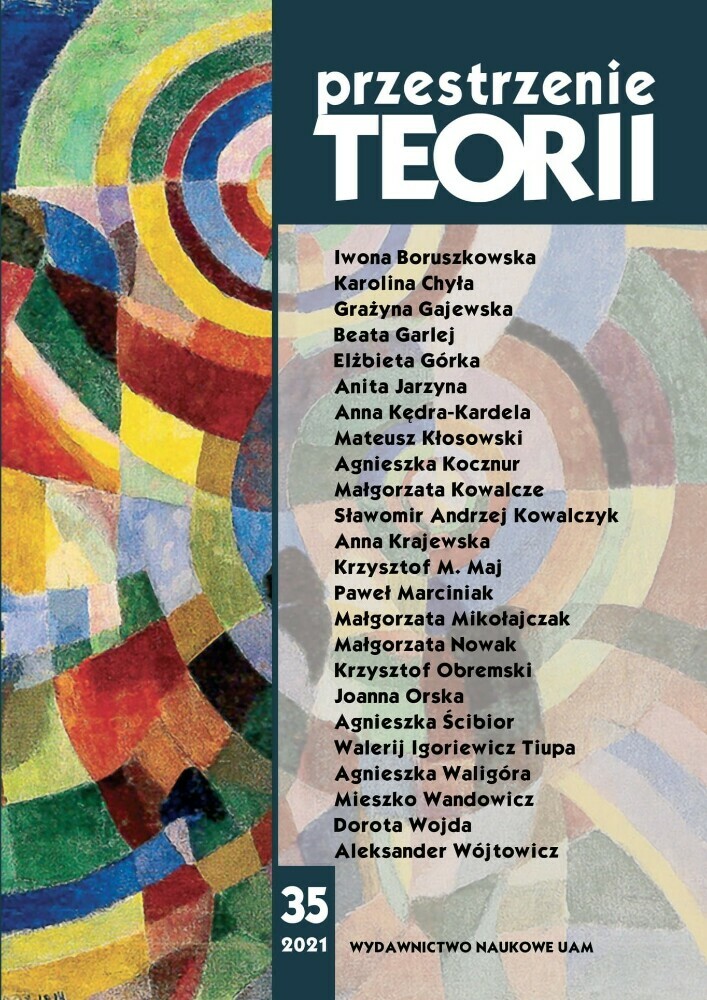Abstract
The author puts forward the thesis that the challenges of the current times resulting from environmental change, the destruction of habitats and ecological disasters direct our sensibilities and aesthetics ever more tangibly towards the fantastic or ecofiction: (eco)horror, (eco)science fiction, or (eco)fantasy. However, while ecohorror mainly exposes the negative aftermath of the Anthropocene, culminating in inevitable disaster, science fiction offers leeway for a more speculative approach, enabling one to construct such visions of reality in which multispecies justice will be observed and cultivated. The author follows K.S. Robinson’s line of thinking that “science fiction is a new realism”, A. Ghosh’s analysis of the relationship between literature and ecology, and D. Haraway’s research on new ways of understanding the relationships between people and non-humans using the speculative potential of sci-fi. It is therefore suggested that there is a great need for a science fiction vision, aesthetic and narration that would be capable of guiding us out of the anthropocentric entanglement and the Anthropocene/Capitalocene into the Chthulucene (as conceived by Haraway).
References
Aleksijewicz S., Czarnobylska modlitwa. Kronika przyszłości, przeł. J. Czech, Wołowiec 2018.
Braidotti R., Po człowieku, przeł. J. Bednarek, A. Kowalczyk, Warszawa 2013.
Disability in Science Fiction. Representations of Technology as Cure, red. K. Allan, New York 2013.
Gajewska G., Arcy-nie-ludzkie. Przez science fiction do antropologii cyborgów, Poznań 2010.
Ghosh A., The Great Derangement. Climate Change and the Unthinkable, Chicago–London 2016.
Haraway D.J., Manifest cyborgów: nauka, technologia i feminizm socjalistyczny lat osiemdziesiątych, przeł. S. Królak i E. Majewska, „Przegląd Filozoficzno-Literacki” 2003, nr 1.
Haraway D.J., Staying with the Trouble. Making Kin in the Chthulucene, Durham–London 2016.
Haraway D.J., The Companion Species Manifesto: Dogs, People, and Significant Otherness, Chicago 2003.
Haraway D.J., Zwierzęta laboratoryjne i ich ludzie, przeł. A. Ostolski, „Krytyka Polityczna” 2008, nr 15.
Lazari-Pawłowska I., Kręgi ludzkiej wspólnoty. Egoizm gatunkowy, [w:] Etyka w teorii i praktyce. Antologia tekstów, red. Z. Kalita, Wrocław 2001.
Lewis S.L., Maslin M.A., The Human Planet. How We Created the Anthropocene, London 2018.
Nayar P.K., Posthumanism, wyd. 2, Cambridge 2017.
Otto E., Science Fiction and the Ecological Conscience, University of Florida 2006, s. 22, <https://ufdc.ufl.edu/UFE0013481/00001> [dostęp: 4.11.2021].
Posthuman Glossary, red. R. Braidotti, M. Hlavajova, Bloomsbury 2018.
Robinson K.R., The Coronavirus is Rewriting Our Imagination, „The New Yorker” 2020, May 1, <https://www.newyorker.com/culture/annals-of-inquiry/the-coronavirus-and-our-future?fbclid=IwAR2S3r7bN2QUnFjlhHQDnEZ0_5bKuVUBymtfdJUSpWbN-M5nmtOzPcV3i2o> [dostęp: 20.10.2021].
Rust S., Soles C., Ecohorror Special Cluster: Living in Fear, Living in Dread, Pretty Soon We’ll All Be Dead, „Interdisciplinary Studies in Literature and Environment” 2014, 21 (3).
Singer P., Animal Liberation. Towards an End to Man’s Inhumanity to Animals, London 1977.
Słownik rodzajów i gatunków literackich, red. G. Gazda, wyd. 2, Warszawa 2019.
Smith J.E.H., It’s All Just Beginning, „Examined Life” 2020, March 23, <https://thepointmag.com/examined-life/its-all-just-beginning/?fbclid=IwAR3N1PpT1bZqU27I7JTg8kQbeukekhHuFDtNkNb0Cwsh8iywfaJHBOeEeUk> [dostęp: 20.10.2021].
Thacker E., In the Dust of This Planet: Horror of Philosophy, Winchester–Washington 2011.
The Cyborg Handbook, red. Ch.H. Gray i in., New York & London 1995.
Vint S., Science Fiction and Posthumanism, „Critical Posthumanism. Genealogy of the Posthuman” 2016, May 24, <https://criticalposthumanism.net/science-fiction/> [dostęp: 20.10.2021].
Žižek S., Patrząc z ukosa. Do Lacana przez kulturę popularną, Warszawa 2003.
License
Authors
Authors of texts accepted for publication in Przestrzenie Teorii are required to complete, sign and return to the editor's office the Agreement for granting a royalty-free license to works with a commitment to grant a CC sub-license.
Under the agreement, the authors of texts published in Przestrzenie Teorii grant the Adam Mickiewicz University in Poznań a non-exclusive, royalty-free license and authorize the use of Attribution-NonCommercial-NoDerivatives 4.0 International (CC BY-NC-ND 4.0) Creative Commons sub-license.
The authors retain the right to continue the free disposal of the work.
Users
Interested Internet users are entitled to use works published in Przestrzenie Teorii since 2015, for non-commercial purposes only, under the following conditions:
- attribution - obligation to provide, together with the distributed work, information about the authorship, title, source (link to the original work, DOI) and the license itself.
- no derivatives - the work must be preserved in its original form, without the author's consent it is not possible to distribute the modified work, such as translations, publications, etc.
Copyrights are reserved for all texts published before 2015.
Miscellaneous
Adam Mickiewicz University in Poznań retains the right to magazines as a whole (layout, graphic form, title, cover design, logo etc.).

